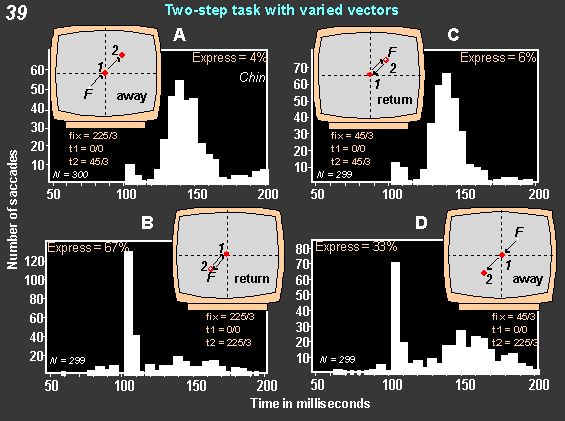The Neural
Control of Visually Guided Eye Movements
D. Temporal Factors in Visually Guided Saccadic Eye Movements
1. The conditions under which express
saccades can and cannot be generated.
i. When successive saccades are generated, does
the frequency with which express saccades are made depend on the direction
of the saccadic vector made relative to the initial fixation?
 It
has been reported by Carpenter (Vision Research, 2001, 41, 1145-1151)
that when humans make saccades to two successive targets, express saccades
are frequent to the second target when it is further away than the first
(away condition) but are not when it appears at a location at or
near the initial fixation spot (return condition). We examined
this in monkeys and could not replicate the reported effect. To determine
what might be going on, we examined the performance of the monkey whose
data had been shown in Figure
37. This animal made profuse express saccades with a vector
of 225/3 and few with a vector of 45/3. We therefore arranged the two
successive targets so that the monkey made his second saccade either toward
or away from fixation with either 225/3 or 45/3 vector saccades. This
was accomplished by strategically placing the fixation spot to appropriate
locations. The distribution of saccadic latencies obtained to the second
target is shown in Figure 39 and
established the following: (1) The monkey made few express saccades for
the away condition when the second saccade had a vector of 45/3
(Figure 39A) and (2) made many express
saccades for the away condition when the second saccade had a vector
of 225/3 (Figure 39D). (3) For the
return conditions (Figure 39B&C)
the monkey again made few express saccades with a vector of 45/3 and many
with a vector of 225/3. Thus the crucial factor in express saccade generation
is not whether the second saccade is toward or away from the fixation
spot but what the direction and amplitude is of the saccadic vector. It
has been reported by Carpenter (Vision Research, 2001, 41, 1145-1151)
that when humans make saccades to two successive targets, express saccades
are frequent to the second target when it is further away than the first
(away condition) but are not when it appears at a location at or
near the initial fixation spot (return condition). We examined
this in monkeys and could not replicate the reported effect. To determine
what might be going on, we examined the performance of the monkey whose
data had been shown in Figure
37. This animal made profuse express saccades with a vector
of 225/3 and few with a vector of 45/3. We therefore arranged the two
successive targets so that the monkey made his second saccade either toward
or away from fixation with either 225/3 or 45/3 vector saccades. This
was accomplished by strategically placing the fixation spot to appropriate
locations. The distribution of saccadic latencies obtained to the second
target is shown in Figure 39 and
established the following: (1) The monkey made few express saccades for
the away condition when the second saccade had a vector of 45/3
(Figure 39A) and (2) made many express
saccades for the away condition when the second saccade had a vector
of 225/3 (Figure 39D). (3) For the
return conditions (Figure 39B&C)
the monkey again made few express saccades with a vector of 45/3 and many
with a vector of 225/3. Thus the crucial factor in express saccade generation
is not whether the second saccade is toward or away from the fixation
spot but what the direction and amplitude is of the saccadic vector.
|